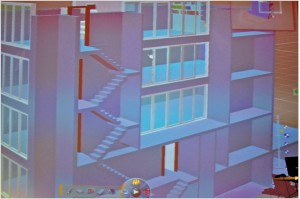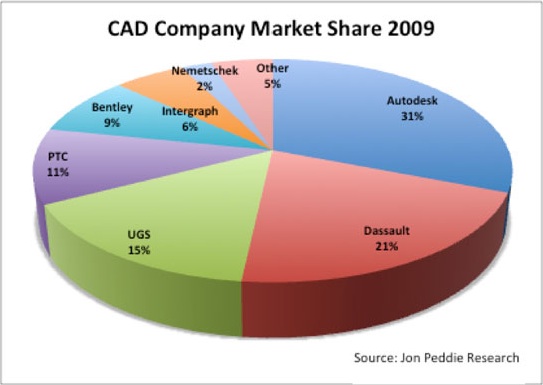Posts Tagged CAD
Flame Virus Wants Your CAD
Posted by Jim Foster in CAD, New Technologies on June 7, 2012
 As reported by Industry Week, ‘The world’s most sophisticated malware had a ‘high interest in AutoCAD drawings,’ Kaspersky Lab said. The Flame Virus, which mainly affected computers in the Middle East used a loophole in Microsoft software tricking computers into thinking they are downloading a legitimate Windows update. This fact, being reported by Reuters, The Times, CNET, and others. CNN reported that Flame can turn on your microphone, webcam, log e-mails, etc. I have not read if it can do anything malicious itself as the Stuxnet Virus did to Iran Uranium enrichment facilities by having centrifuges essentially tear themselves apart. However, going after CAD, essentially engineering and building documents can let whoever is collecting this information know what you are designing and building, and possibly have the blueprints of the building you are designing and building in. And you thought google knowing that you smoke cigars and eat ice cream on your back porch at 5:23 PM was intrusive.
As reported by Industry Week, ‘The world’s most sophisticated malware had a ‘high interest in AutoCAD drawings,’ Kaspersky Lab said. The Flame Virus, which mainly affected computers in the Middle East used a loophole in Microsoft software tricking computers into thinking they are downloading a legitimate Windows update. This fact, being reported by Reuters, The Times, CNET, and others. CNN reported that Flame can turn on your microphone, webcam, log e-mails, etc. I have not read if it can do anything malicious itself as the Stuxnet Virus did to Iran Uranium enrichment facilities by having centrifuges essentially tear themselves apart. However, going after CAD, essentially engineering and building documents can let whoever is collecting this information know what you are designing and building, and possibly have the blueprints of the building you are designing and building in. And you thought google knowing that you smoke cigars and eat ice cream on your back porch at 5:23 PM was intrusive.
BIM to Grow at 17%+ Per Year Through 2020
Posted by Jim Foster in Adoption, BIM on May 9, 2012
 Recently released report from Pike Research suggests that the BIM market for software and services to grow from $1.8 Billion to $6.5 Billion, or a compounded annual growth rate of 17%+. 2D CAD Market as reported by TechNavio is to grow at 7% annually through 2015. So if I were racing… I’d chose the car that’s more than twice as fast.
Recently released report from Pike Research suggests that the BIM market for software and services to grow from $1.8 Billion to $6.5 Billion, or a compounded annual growth rate of 17%+. 2D CAD Market as reported by TechNavio is to grow at 7% annually through 2015. So if I were racing… I’d chose the car that’s more than twice as fast.
Two great tastes together, Revit and AutoCAD make RevitCAD…
Posted by Jim Foster in BIM, CAD, Revit on November 18, 2011
 So I am just adding to the rumor mill, first started, or first heard by me, by Steve Stafford on his twitter feed, so I’ll throw him under the bus if it does not come to pass that the next release of Revit will be “Revit and AutoCAD glued together in one product called ReviCAD….” There has been a lot of bundling going in the recent years such as buy AutoCAD get Revit with it, etc. but not before has it been under one hood, so interesting if you could use AutoCAD’s drafting tool inside of a Revit view, as I’d like that but how about as a tool to increase migration to Revit, although arguably AutoCAD and Revit lead their fields as CAD drafting and BIM authoring platforms, this doesn’t require anyone to make the leap if it’s true, your just in it. So if true, as those guys in the Guiness commercials would say, “Brilliant.”
So I am just adding to the rumor mill, first started, or first heard by me, by Steve Stafford on his twitter feed, so I’ll throw him under the bus if it does not come to pass that the next release of Revit will be “Revit and AutoCAD glued together in one product called ReviCAD….” There has been a lot of bundling going in the recent years such as buy AutoCAD get Revit with it, etc. but not before has it been under one hood, so interesting if you could use AutoCAD’s drafting tool inside of a Revit view, as I’d like that but how about as a tool to increase migration to Revit, although arguably AutoCAD and Revit lead their fields as CAD drafting and BIM authoring platforms, this doesn’t require anyone to make the leap if it’s true, your just in it. So if true, as those guys in the Guiness commercials would say, “Brilliant.”
Work Smarter not Harder? Graphics Standards? Objects? BIM? Building OS
Posted by Jim Foster in architects, BIM, CAD, Standards on July 19, 2011
 In a recent article for the IBTimes, David Fano, Practice 2.0: Work Smarter Not Harder, brings up a good point about working together and developing open source systems and standards. He uses creating a national CAD graphics standard as a jumping off point.
In a recent article for the IBTimes, David Fano, Practice 2.0: Work Smarter Not Harder, brings up a good point about working together and developing open source systems and standards. He uses creating a national CAD graphics standard as a jumping off point.
According to the U.S. Bureau of Labor Statistics, architects held about 141,200 jobs in 2008 (source). Hypothetically, if each architect in the U.S. spends 30 minutes a year on average working on standards, as a profession we spend 70,600 hours on standards every year. Just for reference there are 2,080 hours per year in a standard full-time work week (52 weeks x 40 hours). That’s like a firm of 34 full time architects working on nothing but standards every year.
This same thing is happening on a larger scale with BIM. Each camp developing its own standards, objects and regardless of IFC, are not really good at speaking to each other. Even within a BIM platform, such as Revit, you have modelers who will build window families different from each other, now I’m all for artisans, but this seems to be going a bit far. Now if we want to get to a liquid marketplace where each contractor can bid on a building, or component of a building for construction, fabrication or service we need an open platform that everyone can tie into. What we have are ‘readers’ or ‘compilers’ like Navisworks or now BIM Sight from Tekla/Trimble which can suck in disparate information and display it, good, that’s a good step, but you then don’t do ‘something’ in these products and are they added back to the model, it’s another step to update the model with work that might be done, in stead of giving specific permission to a ‘contractor’ to update the model with the work that was done. Perhaps, will have a ton of translators doing the work of minions, but for now there is still a ton of customization, which is good, but without a common standard, a lot of re-work and cross entry and translation (which is bad).
But the short answer to John’s query about an open source approach to the industry, “yeah, right on!”
BIM CAD Throwdown : Dassault Takes Aim with Catia Live Building and Draftsight
Posted by Jim Foster in 3D, BIM, cloud, New Technologies, Open Standard, SaaS on July 30, 2010
Holy frontal assault Batman. Dassault, the french producer of CATIA (Computer Aided Three-dimensional Interactive Application) / Solidworks is making a strong move into the world of architecture. CATIA, generally used in the aerospace and engineering fields, has also been used successfully by Gehry to produce his curvilinear buildings. They are now introducing 2 products aimed squarely at the Autodesk Bullseye, a CAD application developed through the IntelliCAD Consortium (ITC) and the Open Drawing Alliance (ODA) called Draftsight and its going to be free, yup free. And is available here.
And while it is available for the Windows Family of OS (XP / Vista / Seven) MAC and Linux versions are in the pipeline, take that into account that IBM, you’ve heard of them, markets these solutions worldwide and that complaints about Revit not handling larger products are scattered across user groups and BIM forums one can believe there is an opening. Additionally, if they are following the SaaS path of putting Draftsight in the cloud for file sharing/integrity it becomes a pretty powerful argument to think about switching, especially if all the ingrained keystroke commands and shortcuts from AutoCAD are copied along with it. Having seen the Intellicad interface, I think that most likely a yes.
Excellent article at AEC Magazine that covers the introduction in depth, and thanks to @amonle / John Allsopp twitter for bringing this to my attention. I’ve included a portion below.
Based on a future version of Catia and its data management system Enovia, Dassault Systèmes is developing a competitive parametric modelling solution to compete with Autodesk’s Revit BIM (Building Information Modelling) tool. I understand that the next update of Catia will store its data in the cloud and Catia will potentially be downloaded and licensed from the desktop. This will enable Dassault Systèmes to overcome the fact that it does not have a value-added reseller channel to sell Catia Live Building but needs to compete with an established and low-cost player.
The brief demonstration showed an architectural model being rapidly developed and edited using Catia. Bernard Charlès said that the new product could do modelling in seconds, what Revit would take 45 minutes to do. And Dassault Systèmes should know — it was among the many original investors in the start-up company that developed the first version of Revit.
 While Revit has captured the mindshare here in the US and Down Under among other places no one can discount the Dassault / IBM alliance and their entrance into the AEC industry in a big way. The amount of consulting opportunities and hardware sales should have IBM salivating. So if Draftsight is free, what is Live Building coming in at?
While Revit has captured the mindshare here in the US and Down Under among other places no one can discount the Dassault / IBM alliance and their entrance into the AEC industry in a big way. The amount of consulting opportunities and hardware sales should have IBM salivating. So if Draftsight is free, what is Live Building coming in at?
CAD Rendering in the Cloud : Project Neon
Posted by Jim Foster in CAD, cloud on July 26, 2010
In short order Autodesk Labs is releasing a flurry of projects, and it is stuff that people want to use unlike a sub menu command in Revit 2012 that 12 people rejoice over, this is stuff that people want to use in their day to day. I understand that there have been server farms out there that can be used for rendering and it makes absolute sense. I also understand that there was storage on remote servers and file sync programs for a long time but until jungledisk and dropbox come along to put a pretty bow around it and make it more intuitive the percentage of the population who is going to use it would remain small, better software, better interface, bigger pie, exponentially bigger pie.
Project Neon allows for the export of dwg into the cloud viw the Neon interface, set parameters, and let it go to work. Not ever having to watch a painful block by block rendering, much like an 96 year old man shoveling a 200 yard driveway is worth the price of admission alone, which did I tell you, is free.
Project Butterfly : Autodesk continues with SaaS : #BIM #CAD #saas
Posted by Jim Foster in CAD, cloud, New Technologies, SaaS on July 22, 2010
Autodesk continues to move forward with their Saas (software as a service) offerings. While Project Twitch allowed users to test drive a variety of software without saving or uploading anything Project Butterfly give you space in the cloud to upload your files and drive through them, collaborate, save all within a web base AutoCAD environment. I have just started playing around with it, although it has been out for awhile and although there is a bit of lag but it still delivers. I believe getting files, models, etc. in the cloud is the beginning. The start of real collaboration, the start of value added services, the start of a more efficient work place and the market leader is starting to figure it out.
Mac : AutoCAD : Sledgehammer: kaPOW
Posted by Jim Foster in CAD on May 24, 2010
 Reports coming over the interweb that Autodesk will be releasing a version of AutoCAD native for the Mac. For someone writing this on a Mac while AutoCAD Architecture / ADT is running on on Parallels (PC Simulator) simultaneously this is initially a big yawn. However, for the fervent MAC camp that rather ride down a razor railing than use anything PC related this has to be met with much joy and confirmation that the MAC platform is superior and even the big boys now have to admit it and start creating or recreating native programs for the MAC. The bigger question remains why? My guess? Because Apple is ‘cool’ and so, then why not.
Reports coming over the interweb that Autodesk will be releasing a version of AutoCAD native for the Mac. For someone writing this on a Mac while AutoCAD Architecture / ADT is running on on Parallels (PC Simulator) simultaneously this is initially a big yawn. However, for the fervent MAC camp that rather ride down a razor railing than use anything PC related this has to be met with much joy and confirmation that the MAC platform is superior and even the big boys now have to admit it and start creating or recreating native programs for the MAC. The bigger question remains why? My guess? Because Apple is ‘cool’ and so, then why not.
I first saw this over at Architosh, where the article goes into further depth about how it was programmed, Cocoa v. Aqua which has absolutely no relevance to me, as with my refrigerator, I plug it in, it makes things cold as I load software, I expect it to work. From a development standpoint I’ll have to ask some people smarter than me how easy–> difficult it will be to port programs from Windows to Mac environment but we’ll have to wait for the real release.
Also below is youtube video showing it running,
CAD Market / BIM Market 2010 : Installed Base : Ouch.
Posted by Jim Foster in 3D, Autodesk, BIM, economic trends, Installed Seats on May 6, 2010
So earlier in these ruminations I stated that I thought 30% less was the new watermark, that is, 30% less work out there, 30% off what used to be a winning bid. Early market data from Jon Peddie Research, shows a 22% drop in 2009 CAD revenues as compared to 2010. This is just on the software side, not services, which we can argue would be worse. Subscriptions are down because why renew an empty seat as are new sales. This report deals with CAD on all levels from designing parts to designing buildings but still gives a good overview of the industry. The good news for those embracing BIM is that they reaffirm other anecdotal information that BIM is a bottom up phenomena not a mandate from management. That is, the people building the buildings are the ones who are using not because of perceived value or marketing spin but because it adds value. Hammer..check…Compressor…check…BIM model…
Updated Aug 2010
I noticed a lot of traffic to this page, and also noticed that the link to the report required a log in so decided to quote it here.
Let’s just get this over with: the year 2009 was a disaster in the CAD industry. According to our latest report, the CAD industry saw revenues of $5.1 billion, a 22% drop compared to 2008 and although the picture is improving for 2010, there is no rebound because that’s just not the way the CAD industry works, and worse, that’s not how this recession worked.
The CAD industry cannot turn on a dime because it’s part of larger systems. At this year’s Autodesk University, Carl Bass noted that subscriptions were down because there’s not much reason to maintain a subscription for empty seats. Unfortunately, there are a lot of empty seats for all CAD systems worldwide. We estimate that approximately 200,000 workers left the CAD industry worldwide. And, it can be added, we believe this is a conservative view.
In this latest report we have seen an interesting trend as Building Information Modeling (BIM) becomes accepted in the engineering, architecture and construction (AEC) industry. The similar discipline, PLM is just about ubiquitous in MCAD but as it was being introduced into the MCAD industry in the early 90s, it was essentially implemented in a top-down process as management signed up for the advantages that come with a consistent and connected data pipeline. In contrast, BIM in the architectural fields is being driven by those at the end of the pipeline in building and construction.



